Economics Assignment: Microeconomic and Macroeconomic Analysis
VerifiedAdded on 2023/04/21
|28
|3427
|471
Homework Assignment
AI Summary
This business economics assignment provides a detailed analysis of both microeconomic and macroeconomic principles. Part A delves into microeconomic concepts, including demand and supply analysis, elasticity, market structures (perfect competition), and cost structures. It explores how changes in factors like oil prices, income, and external benefits/costs affect market outcomes. Part B focuses on macroeconomic topics, such as calculating GDP, GNP, and NNP, and analyzing the effects of fiscal policy, changes in workforce skills, exports, and capital stock on aggregate demand and supply. The assignment covers topics like opportunity cost, the impact of taxes, and the factors affecting economic growth and stability, providing a comprehensive overview of core economic concepts. The assignment includes figures to demonstrate key concepts and calculations, making it a valuable resource for students studying economics.
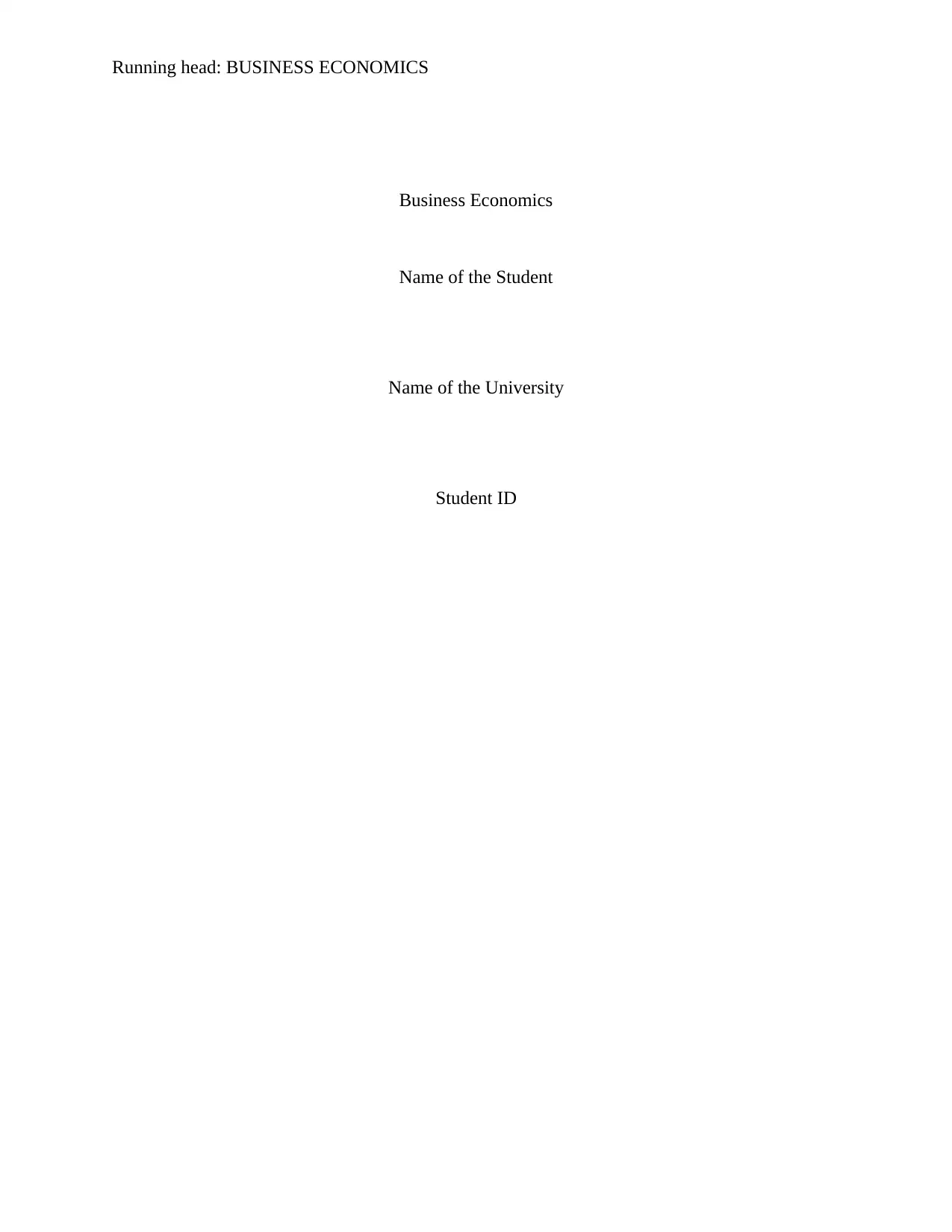
Running head: BUSINESS ECONOMICS
Business Economics
Name of the Student
Name of the University
Student ID
Business Economics
Name of the Student
Name of the University
Student ID
Paraphrase This Document
Need a fresh take? Get an instant paraphrase of this document with our AI Paraphraser
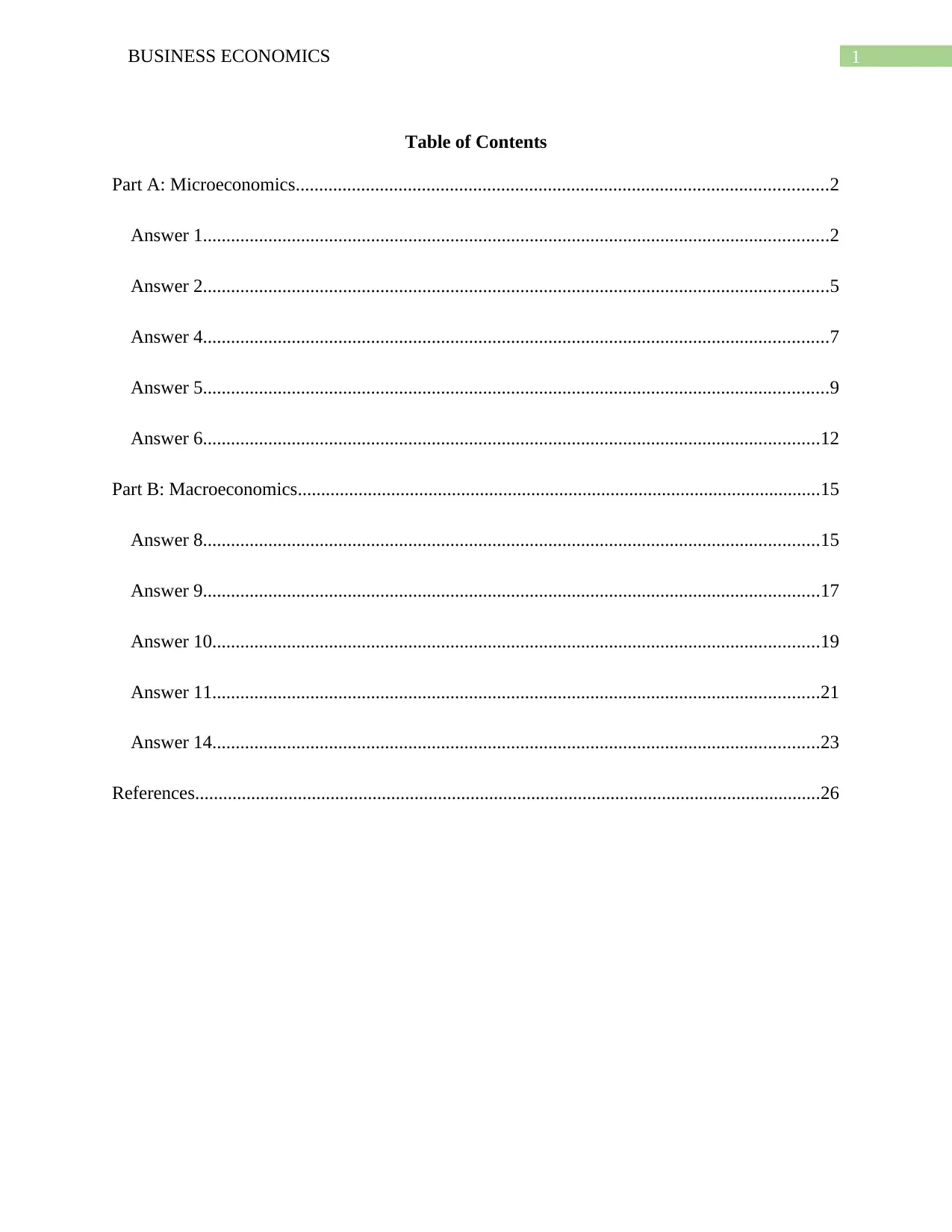
1BUSINESS ECONOMICS
Table of Contents
Part A: Microeconomics..................................................................................................................2
Answer 1......................................................................................................................................2
Answer 2......................................................................................................................................5
Answer 4......................................................................................................................................7
Answer 5......................................................................................................................................9
Answer 6....................................................................................................................................12
Part B: Macroeconomics................................................................................................................15
Answer 8....................................................................................................................................15
Answer 9....................................................................................................................................17
Answer 10..................................................................................................................................19
Answer 11..................................................................................................................................21
Answer 14..................................................................................................................................23
References......................................................................................................................................26
Table of Contents
Part A: Microeconomics..................................................................................................................2
Answer 1......................................................................................................................................2
Answer 2......................................................................................................................................5
Answer 4......................................................................................................................................7
Answer 5......................................................................................................................................9
Answer 6....................................................................................................................................12
Part B: Macroeconomics................................................................................................................15
Answer 8....................................................................................................................................15
Answer 9....................................................................................................................................17
Answer 10..................................................................................................................................19
Answer 11..................................................................................................................................21
Answer 14..................................................................................................................................23
References......................................................................................................................................26

2BUSINESS ECONOMICS
Part A: Microeconomics
Answer 1
Answer a
i)
With increase in oil price, there would be a decline in demand for automobile. As a result,
demand curve of automobile shifts to the leftward direction.
Figure 1: Demand for automobile
ii)
People are more encouraged to install home installation for efficient use of energy. As a result,
demand for home insulation increases, demand curve of home insulation shifts to the rightward
direction.
Part A: Microeconomics
Answer 1
Answer a
i)
With increase in oil price, there would be a decline in demand for automobile. As a result,
demand curve of automobile shifts to the leftward direction.
Figure 1: Demand for automobile
ii)
People are more encouraged to install home installation for efficient use of energy. As a result,
demand for home insulation increases, demand curve of home insulation shifts to the rightward
direction.
⊘ This is a preview!⊘
Do you want full access?
Subscribe today to unlock all pages.

Trusted by 1+ million students worldwide
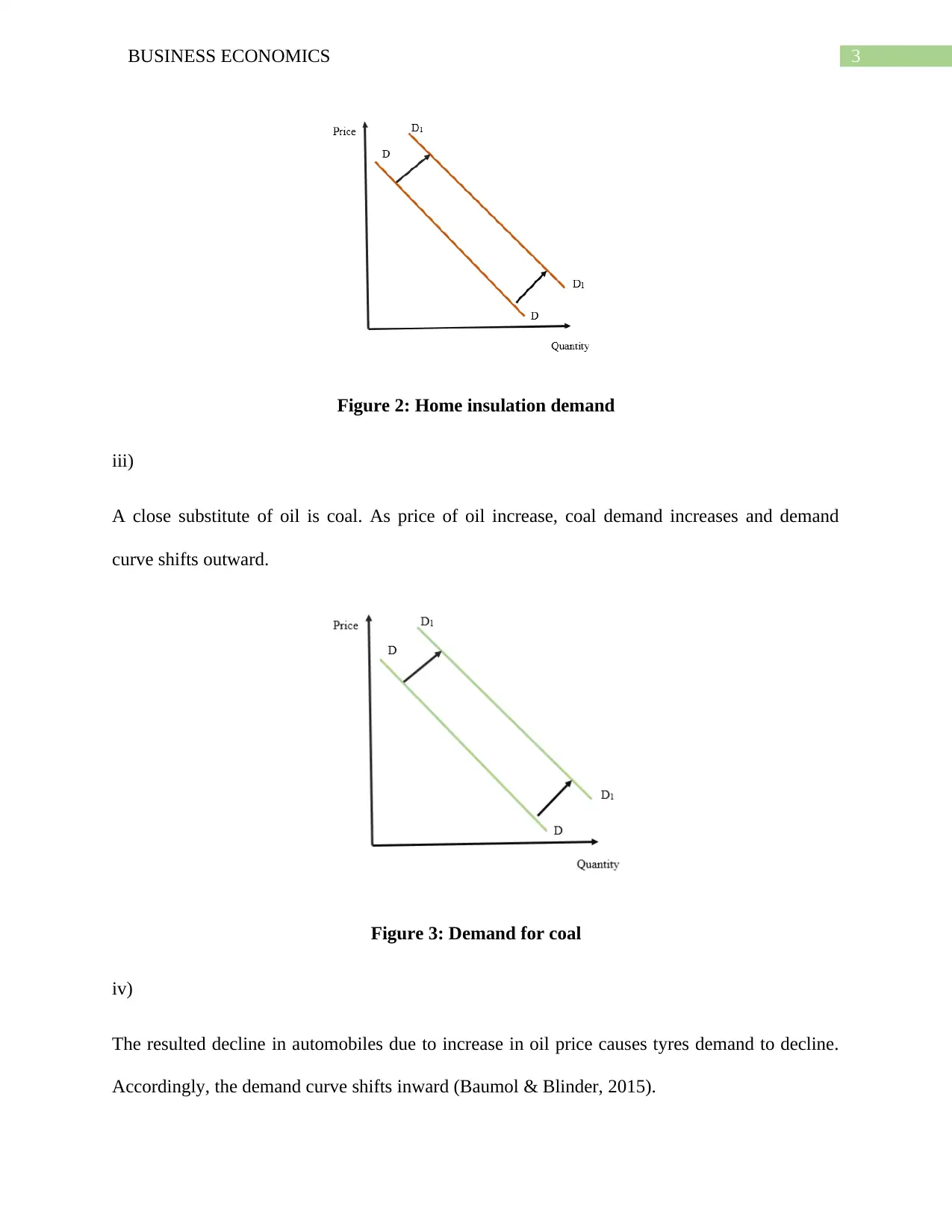
3BUSINESS ECONOMICS
Figure 2: Home insulation demand
iii)
A close substitute of oil is coal. As price of oil increase, coal demand increases and demand
curve shifts outward.
Figure 3: Demand for coal
iv)
The resulted decline in automobiles due to increase in oil price causes tyres demand to decline.
Accordingly, the demand curve shifts inward (Baumol & Blinder, 2015).
Figure 2: Home insulation demand
iii)
A close substitute of oil is coal. As price of oil increase, coal demand increases and demand
curve shifts outward.
Figure 3: Demand for coal
iv)
The resulted decline in automobiles due to increase in oil price causes tyres demand to decline.
Accordingly, the demand curve shifts inward (Baumol & Blinder, 2015).
Paraphrase This Document
Need a fresh take? Get an instant paraphrase of this document with our AI Paraphraser
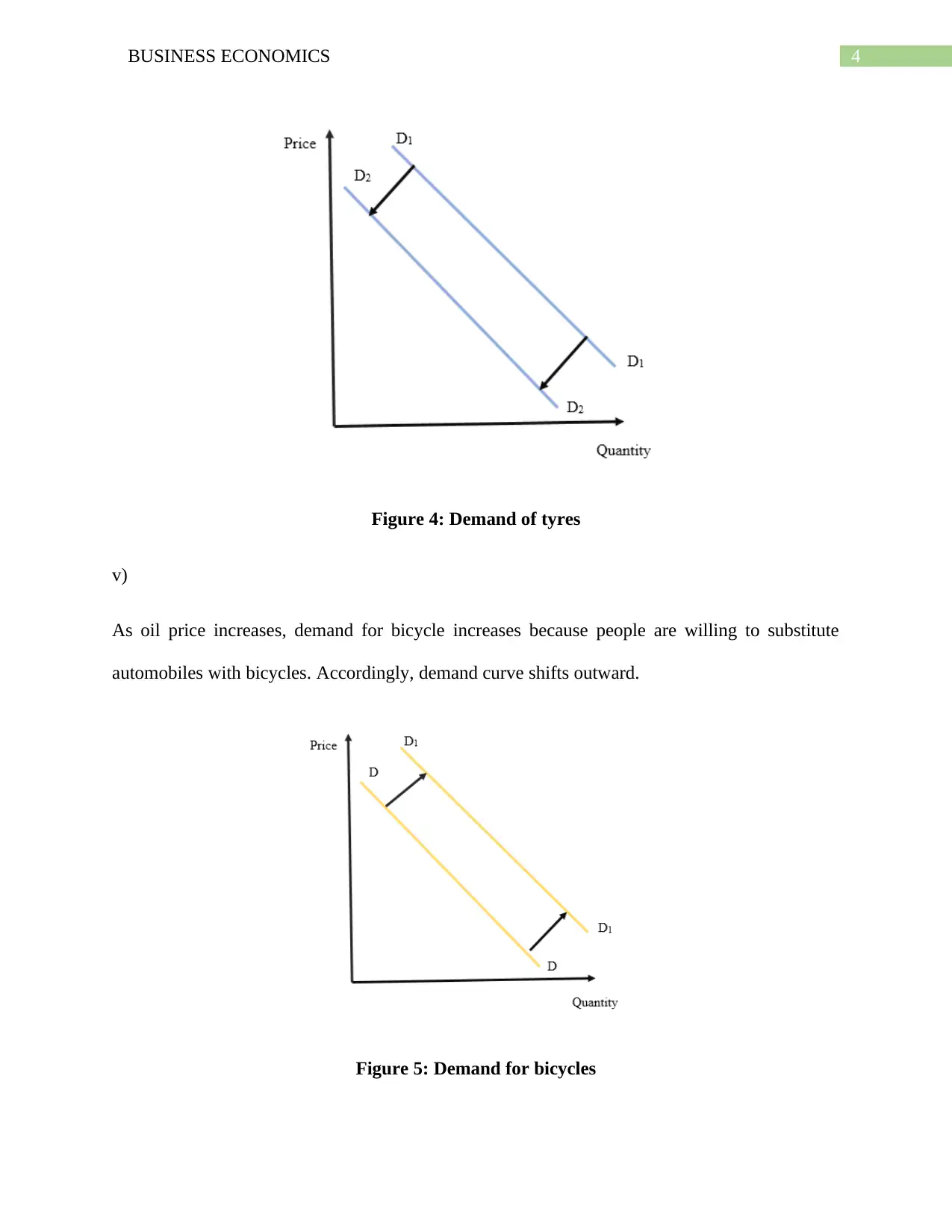
4BUSINESS ECONOMICS
Figure 4: Demand of tyres
v)
As oil price increases, demand for bicycle increases because people are willing to substitute
automobiles with bicycles. Accordingly, demand curve shifts outward.
Figure 5: Demand for bicycles
Figure 4: Demand of tyres
v)
As oil price increases, demand for bicycle increases because people are willing to substitute
automobiles with bicycles. Accordingly, demand curve shifts outward.
Figure 5: Demand for bicycles
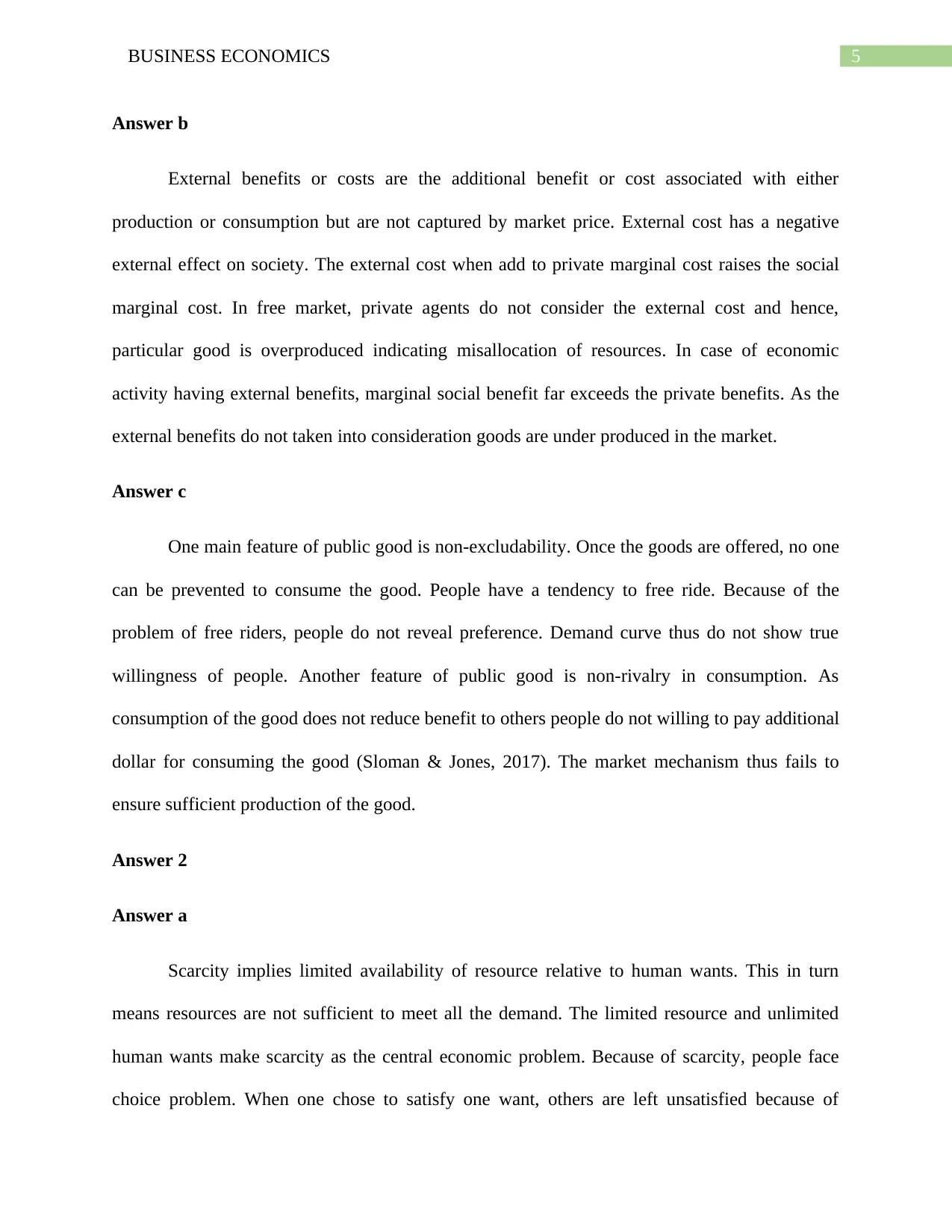
5BUSINESS ECONOMICS
Answer b
External benefits or costs are the additional benefit or cost associated with either
production or consumption but are not captured by market price. External cost has a negative
external effect on society. The external cost when add to private marginal cost raises the social
marginal cost. In free market, private agents do not consider the external cost and hence,
particular good is overproduced indicating misallocation of resources. In case of economic
activity having external benefits, marginal social benefit far exceeds the private benefits. As the
external benefits do not taken into consideration goods are under produced in the market.
Answer c
One main feature of public good is non-excludability. Once the goods are offered, no one
can be prevented to consume the good. People have a tendency to free ride. Because of the
problem of free riders, people do not reveal preference. Demand curve thus do not show true
willingness of people. Another feature of public good is non-rivalry in consumption. As
consumption of the good does not reduce benefit to others people do not willing to pay additional
dollar for consuming the good (Sloman & Jones, 2017). The market mechanism thus fails to
ensure sufficient production of the good.
Answer 2
Answer a
Scarcity implies limited availability of resource relative to human wants. This in turn
means resources are not sufficient to meet all the demand. The limited resource and unlimited
human wants make scarcity as the central economic problem. Because of scarcity, people face
choice problem. When one chose to satisfy one want, others are left unsatisfied because of
Answer b
External benefits or costs are the additional benefit or cost associated with either
production or consumption but are not captured by market price. External cost has a negative
external effect on society. The external cost when add to private marginal cost raises the social
marginal cost. In free market, private agents do not consider the external cost and hence,
particular good is overproduced indicating misallocation of resources. In case of economic
activity having external benefits, marginal social benefit far exceeds the private benefits. As the
external benefits do not taken into consideration goods are under produced in the market.
Answer c
One main feature of public good is non-excludability. Once the goods are offered, no one
can be prevented to consume the good. People have a tendency to free ride. Because of the
problem of free riders, people do not reveal preference. Demand curve thus do not show true
willingness of people. Another feature of public good is non-rivalry in consumption. As
consumption of the good does not reduce benefit to others people do not willing to pay additional
dollar for consuming the good (Sloman & Jones, 2017). The market mechanism thus fails to
ensure sufficient production of the good.
Answer 2
Answer a
Scarcity implies limited availability of resource relative to human wants. This in turn
means resources are not sufficient to meet all the demand. The limited resource and unlimited
human wants make scarcity as the central economic problem. Because of scarcity, people face
choice problem. When one chose to satisfy one want, others are left unsatisfied because of
⊘ This is a preview!⊘
Do you want full access?
Subscribe today to unlock all pages.

Trusted by 1+ million students worldwide
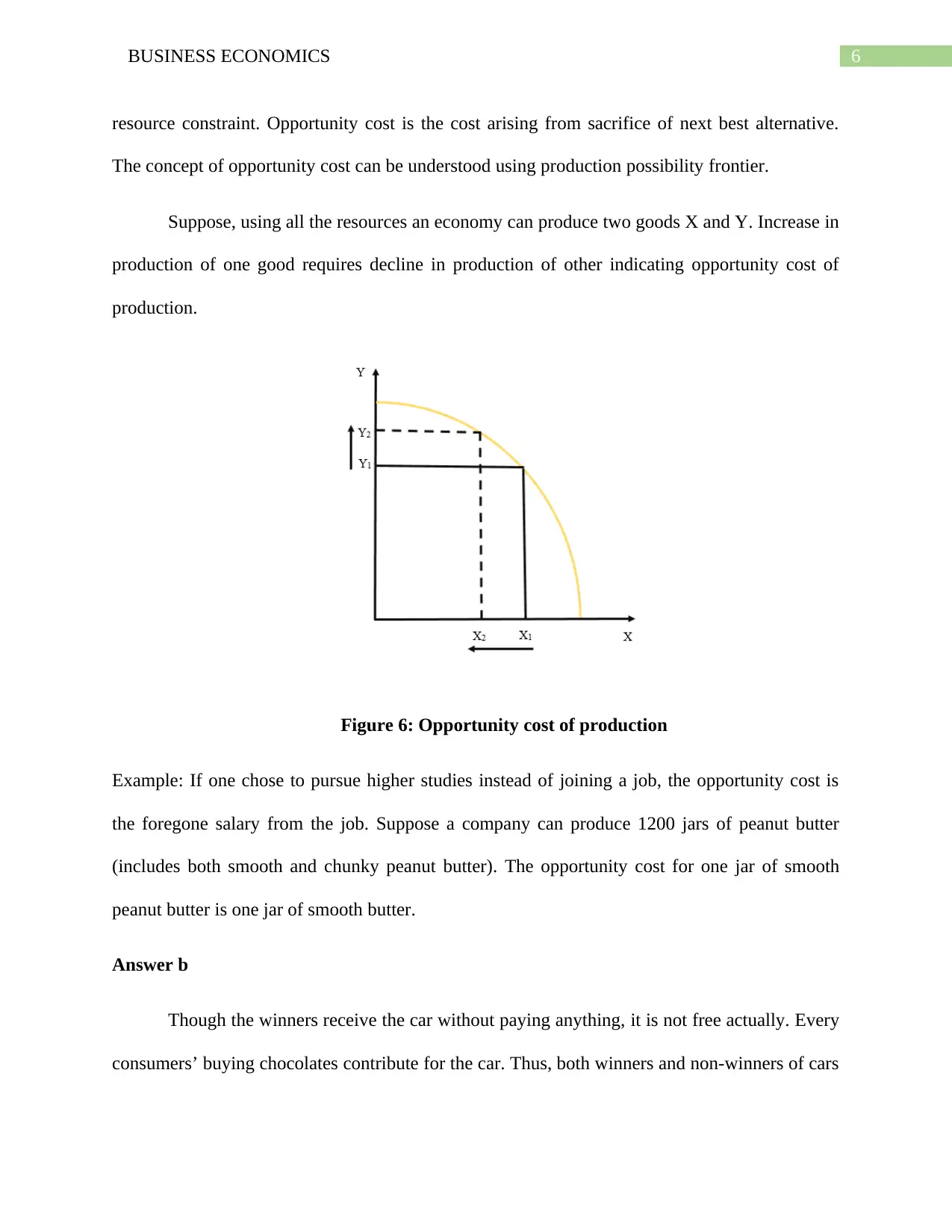
6BUSINESS ECONOMICS
resource constraint. Opportunity cost is the cost arising from sacrifice of next best alternative.
The concept of opportunity cost can be understood using production possibility frontier.
Suppose, using all the resources an economy can produce two goods X and Y. Increase in
production of one good requires decline in production of other indicating opportunity cost of
production.
Figure 6: Opportunity cost of production
Example: If one chose to pursue higher studies instead of joining a job, the opportunity cost is
the foregone salary from the job. Suppose a company can produce 1200 jars of peanut butter
(includes both smooth and chunky peanut butter). The opportunity cost for one jar of smooth
peanut butter is one jar of smooth butter.
Answer b
Though the winners receive the car without paying anything, it is not free actually. Every
consumers’ buying chocolates contribute for the car. Thus, both winners and non-winners of cars
resource constraint. Opportunity cost is the cost arising from sacrifice of next best alternative.
The concept of opportunity cost can be understood using production possibility frontier.
Suppose, using all the resources an economy can produce two goods X and Y. Increase in
production of one good requires decline in production of other indicating opportunity cost of
production.
Figure 6: Opportunity cost of production
Example: If one chose to pursue higher studies instead of joining a job, the opportunity cost is
the foregone salary from the job. Suppose a company can produce 1200 jars of peanut butter
(includes both smooth and chunky peanut butter). The opportunity cost for one jar of smooth
peanut butter is one jar of smooth butter.
Answer b
Though the winners receive the car without paying anything, it is not free actually. Every
consumers’ buying chocolates contribute for the car. Thus, both winners and non-winners of cars
Paraphrase This Document
Need a fresh take? Get an instant paraphrase of this document with our AI Paraphraser
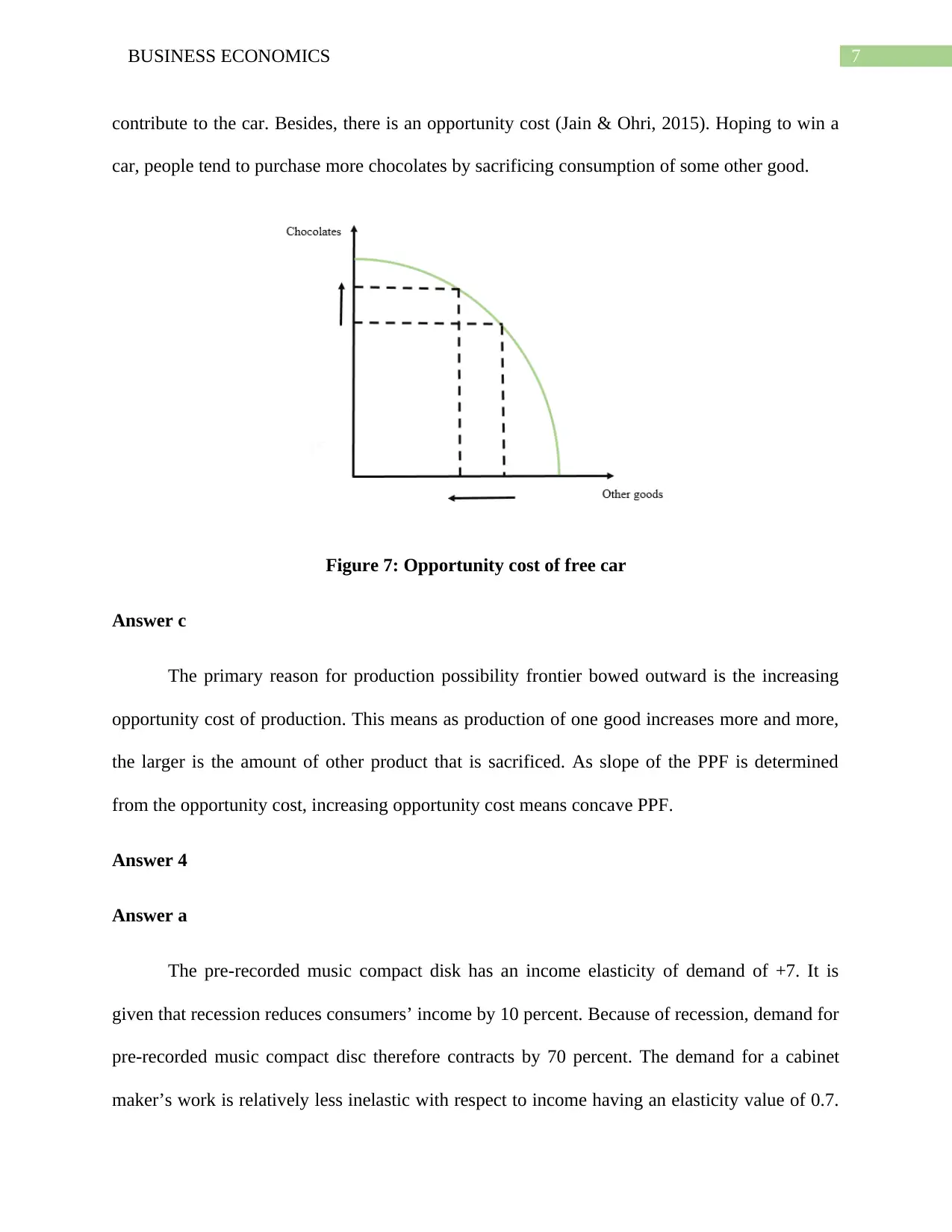
7BUSINESS ECONOMICS
contribute to the car. Besides, there is an opportunity cost (Jain & Ohri, 2015). Hoping to win a
car, people tend to purchase more chocolates by sacrificing consumption of some other good.
Figure 7: Opportunity cost of free car
Answer c
The primary reason for production possibility frontier bowed outward is the increasing
opportunity cost of production. This means as production of one good increases more and more,
the larger is the amount of other product that is sacrificed. As slope of the PPF is determined
from the opportunity cost, increasing opportunity cost means concave PPF.
Answer 4
Answer a
The pre-recorded music compact disk has an income elasticity of demand of +7. It is
given that recession reduces consumers’ income by 10 percent. Because of recession, demand for
pre-recorded music compact disc therefore contracts by 70 percent. The demand for a cabinet
maker’s work is relatively less inelastic with respect to income having an elasticity value of 0.7.
contribute to the car. Besides, there is an opportunity cost (Jain & Ohri, 2015). Hoping to win a
car, people tend to purchase more chocolates by sacrificing consumption of some other good.
Figure 7: Opportunity cost of free car
Answer c
The primary reason for production possibility frontier bowed outward is the increasing
opportunity cost of production. This means as production of one good increases more and more,
the larger is the amount of other product that is sacrificed. As slope of the PPF is determined
from the opportunity cost, increasing opportunity cost means concave PPF.
Answer 4
Answer a
The pre-recorded music compact disk has an income elasticity of demand of +7. It is
given that recession reduces consumers’ income by 10 percent. Because of recession, demand for
pre-recorded music compact disc therefore contracts by 70 percent. The demand for a cabinet
maker’s work is relatively less inelastic with respect to income having an elasticity value of 0.7.
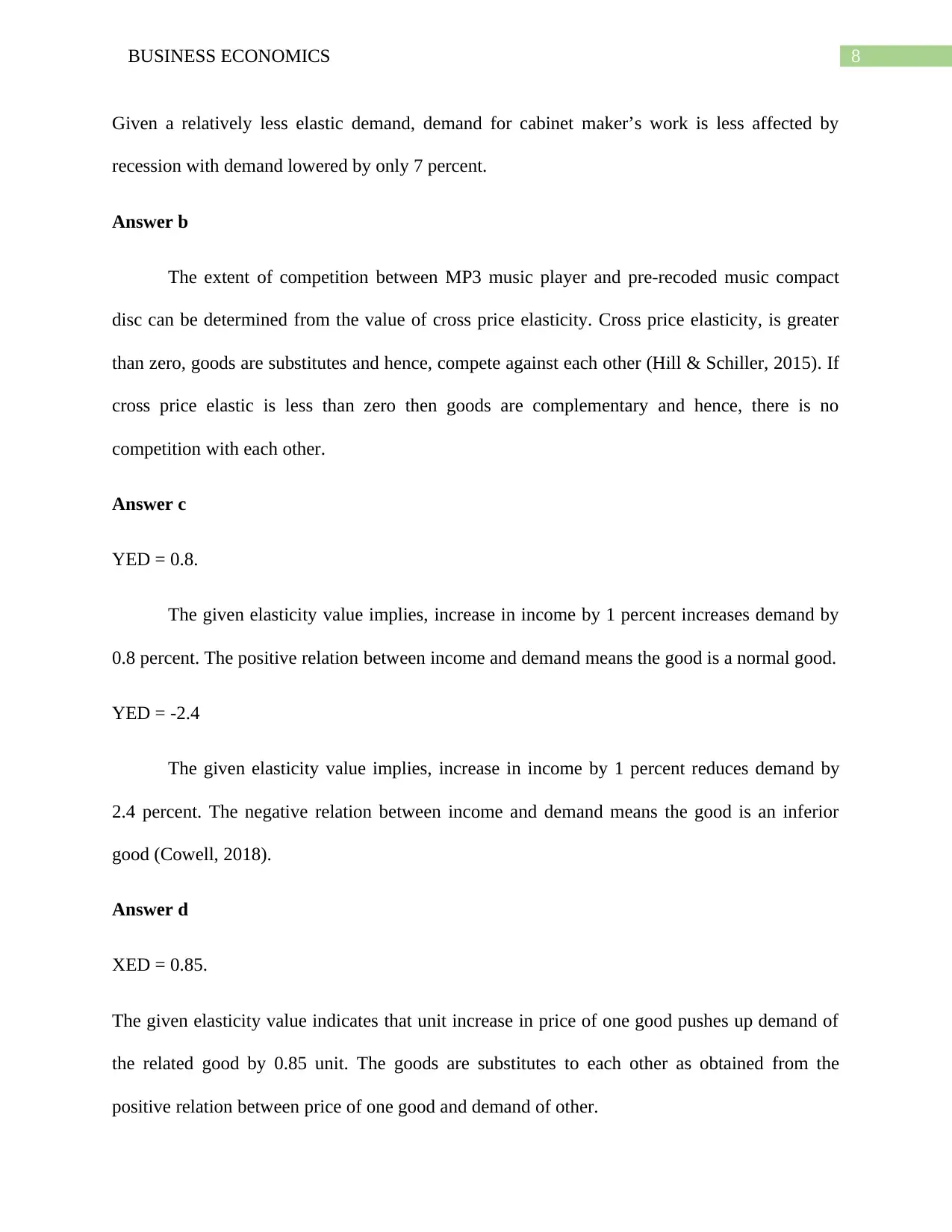
8BUSINESS ECONOMICS
Given a relatively less elastic demand, demand for cabinet maker’s work is less affected by
recession with demand lowered by only 7 percent.
Answer b
The extent of competition between MP3 music player and pre-recoded music compact
disc can be determined from the value of cross price elasticity. Cross price elasticity, is greater
than zero, goods are substitutes and hence, compete against each other (Hill & Schiller, 2015). If
cross price elastic is less than zero then goods are complementary and hence, there is no
competition with each other.
Answer c
YED = 0.8.
The given elasticity value implies, increase in income by 1 percent increases demand by
0.8 percent. The positive relation between income and demand means the good is a normal good.
YED = -2.4
The given elasticity value implies, increase in income by 1 percent reduces demand by
2.4 percent. The negative relation between income and demand means the good is an inferior
good (Cowell, 2018).
Answer d
XED = 0.85.
The given elasticity value indicates that unit increase in price of one good pushes up demand of
the related good by 0.85 unit. The goods are substitutes to each other as obtained from the
positive relation between price of one good and demand of other.
Given a relatively less elastic demand, demand for cabinet maker’s work is less affected by
recession with demand lowered by only 7 percent.
Answer b
The extent of competition between MP3 music player and pre-recoded music compact
disc can be determined from the value of cross price elasticity. Cross price elasticity, is greater
than zero, goods are substitutes and hence, compete against each other (Hill & Schiller, 2015). If
cross price elastic is less than zero then goods are complementary and hence, there is no
competition with each other.
Answer c
YED = 0.8.
The given elasticity value implies, increase in income by 1 percent increases demand by
0.8 percent. The positive relation between income and demand means the good is a normal good.
YED = -2.4
The given elasticity value implies, increase in income by 1 percent reduces demand by
2.4 percent. The negative relation between income and demand means the good is an inferior
good (Cowell, 2018).
Answer d
XED = 0.85.
The given elasticity value indicates that unit increase in price of one good pushes up demand of
the related good by 0.85 unit. The goods are substitutes to each other as obtained from the
positive relation between price of one good and demand of other.
⊘ This is a preview!⊘
Do you want full access?
Subscribe today to unlock all pages.

Trusted by 1+ million students worldwide
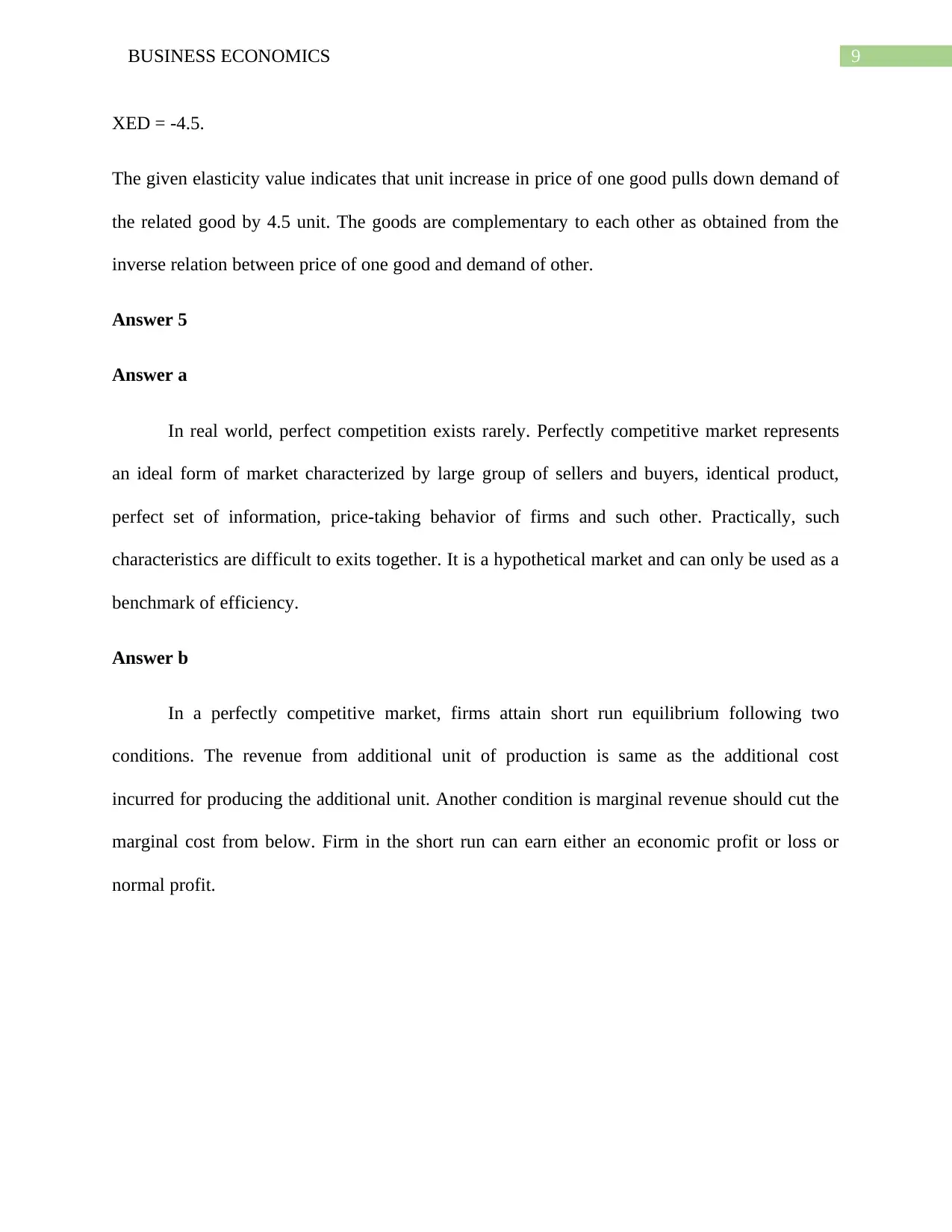
9BUSINESS ECONOMICS
XED = -4.5.
The given elasticity value indicates that unit increase in price of one good pulls down demand of
the related good by 4.5 unit. The goods are complementary to each other as obtained from the
inverse relation between price of one good and demand of other.
Answer 5
Answer a
In real world, perfect competition exists rarely. Perfectly competitive market represents
an ideal form of market characterized by large group of sellers and buyers, identical product,
perfect set of information, price-taking behavior of firms and such other. Practically, such
characteristics are difficult to exits together. It is a hypothetical market and can only be used as a
benchmark of efficiency.
Answer b
In a perfectly competitive market, firms attain short run equilibrium following two
conditions. The revenue from additional unit of production is same as the additional cost
incurred for producing the additional unit. Another condition is marginal revenue should cut the
marginal cost from below. Firm in the short run can earn either an economic profit or loss or
normal profit.
XED = -4.5.
The given elasticity value indicates that unit increase in price of one good pulls down demand of
the related good by 4.5 unit. The goods are complementary to each other as obtained from the
inverse relation between price of one good and demand of other.
Answer 5
Answer a
In real world, perfect competition exists rarely. Perfectly competitive market represents
an ideal form of market characterized by large group of sellers and buyers, identical product,
perfect set of information, price-taking behavior of firms and such other. Practically, such
characteristics are difficult to exits together. It is a hypothetical market and can only be used as a
benchmark of efficiency.
Answer b
In a perfectly competitive market, firms attain short run equilibrium following two
conditions. The revenue from additional unit of production is same as the additional cost
incurred for producing the additional unit. Another condition is marginal revenue should cut the
marginal cost from below. Firm in the short run can earn either an economic profit or loss or
normal profit.
Paraphrase This Document
Need a fresh take? Get an instant paraphrase of this document with our AI Paraphraser

10BUSINESS ECONOMICS
Figure 8: short run profit for competitive firm
Figure 9: short run loss for competitive firm
Figure 8: short run profit for competitive firm
Figure 9: short run loss for competitive firm
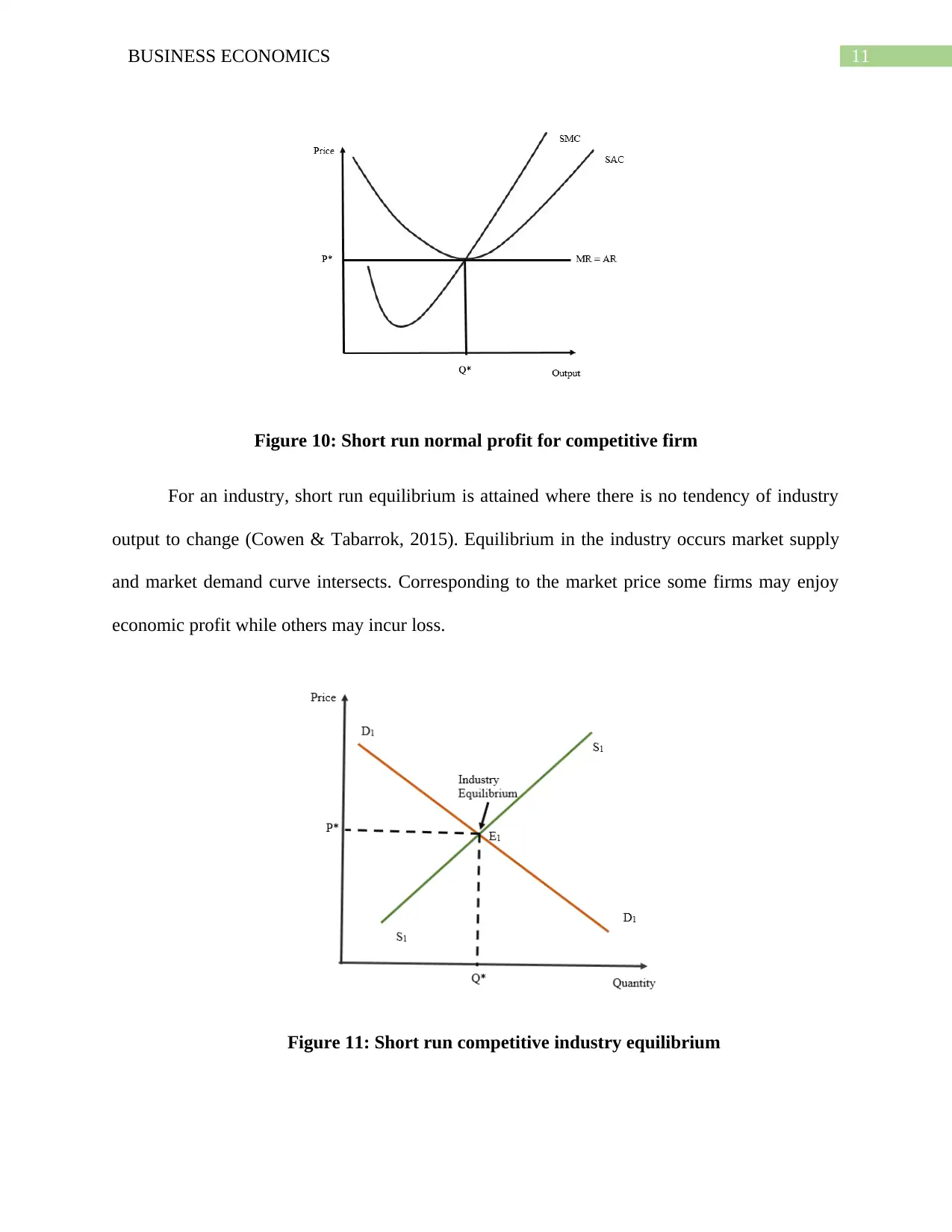
11BUSINESS ECONOMICS
Figure 10: Short run normal profit for competitive firm
For an industry, short run equilibrium is attained where there is no tendency of industry
output to change (Cowen & Tabarrok, 2015). Equilibrium in the industry occurs market supply
and market demand curve intersects. Corresponding to the market price some firms may enjoy
economic profit while others may incur loss.
Figure 11: Short run competitive industry equilibrium
Figure 10: Short run normal profit for competitive firm
For an industry, short run equilibrium is attained where there is no tendency of industry
output to change (Cowen & Tabarrok, 2015). Equilibrium in the industry occurs market supply
and market demand curve intersects. Corresponding to the market price some firms may enjoy
economic profit while others may incur loss.
Figure 11: Short run competitive industry equilibrium
⊘ This is a preview!⊘
Do you want full access?
Subscribe today to unlock all pages.

Trusted by 1+ million students worldwide
1 out of 28
Related Documents
Your All-in-One AI-Powered Toolkit for Academic Success.
+13062052269
info@desklib.com
Available 24*7 on WhatsApp / Email
![[object Object]](/_next/static/media/star-bottom.7253800d.svg)
Unlock your academic potential
Copyright © 2020–2026 A2Z Services. All Rights Reserved. Developed and managed by ZUCOL.




